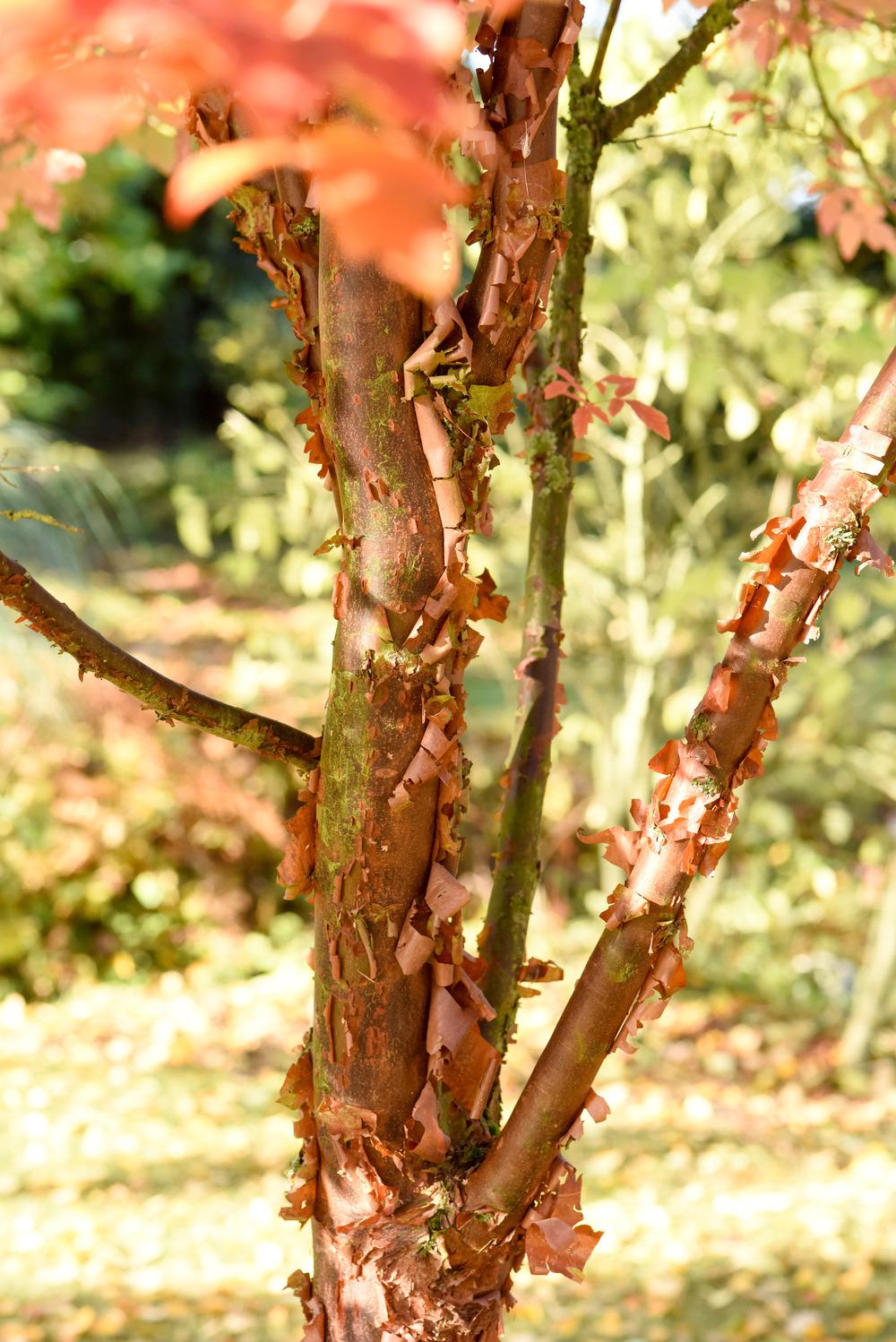By Andrew Bunting, November 30, 2022
As the days get longer and the temperatures get colder, the need for beauty in the garden is especially important. There are several considerations the home gardener can make to add beauty by using shrubs with beautifully colored stems, or trees with interesting bark, as well as plants with great foliage, fruits, and even flowers.
Beautiful Stems for the Garden
Many of the red-stemmed dogwoods are great for winter interest. During the summer, these shrubs reach 5 to 8 feet tall and have multiple green stems about a pencil's width. As the leaves fall off with colder weather, the stems turn to dazzling colors. For example,
Cornus sericea ‘Cardinal’ has salmon-pink stems. The impact is elevated when these shrubs are planted in masses in front of an evergreen backdrop such as
Thuja ‘Green Giant’ or
Cryptomeria japonica ‘Yoshino’.
Cornus sanguinea Arctic Sun® has a suffusion of pink to orange to yellow stems and is a little more diminutive in stature compared to ‘Cardinal.’ Arctic Fire® has striking fire-engine red stems, and ‘
Flaviramea’ produces bright yellow stems for winter interest. In addition to being great plants for winter interest in the garden, these can all be cut for winter wreaths, or used for indoor bouquets.
The Best Bark
As leaves begin to drop in the fall, many trees reveal exquisite bark that can provide amazing winter interest. The paperbark maple,
Acer griseum has luxuriant, peeling, coppery bark. This medium-sized tree will reach approximately 30 feet tall at maturity. It is best offset with a low groundcover that can accent the trunk and fully reveal the bark. The lacebark pine,
Pinus bungeana is aptly named, and its bark develops over many years if not many decades. In its youth, it is a mottled tapestry that looks like a patchwork of various greens, beiges, and white. As the pine matures and the lower branches fall off or are removed, patches of green and white will spread, and the stems reveal more white. Mature specimens can have an alabaster white trunk. Additionally, there are many wonderful stewartias with beautiful bark. The best for the home garden is the Japanese stewartia,
Stewartia pseudocamellia. This small flowering tree is highlighted by summer camellia-like flowers that are white with a yellow center followed by a wine-red color. As the leaves fall, the smooth sinuous bark is revealed. As the bark flakes off, it reveals a blended pattern of grey, brown, rust, and white.
Flowers in Winter
While winter temperatures might seem inhospitable for most flowering plants, some plants will flower in the winter. The witch-hazel's,
Hamamelis x intermedia have narrow strap-like, crinkled flowers on the branches of this upright shrub or small tree. There are many exceptional cultivars that range in flower colors from yellow, to orange, to red, and many are fragrant, making it the perfect plant to cut stems and bring in to perfume the home. ‘
Jelena’ is an upright, vase-shaped shrub reaching 15 feet tall and wide at maturity. In mid-February, it is adorned with many coppery orange flowers. ‘
Primavera’ has bright golden-yellow flowers and ‘
Strawberries and Cream’ are just that; cream and strawberry-red flowers blended.
Another winter flowering favorite is the wintersweet. It is aptly named for the pendant, creamy yellow, bell-shaped flowers that are intensely fragrant and can bloom as early as January. Additionally, the paper bush, Edgeworthia chrysantha also provides winter flowers, and can reach 8 feet tall and wide at maturity. This relative of the Daphnes forms its clusters of flower buds in the late summer. The buds are covered with silver fuzz and can be attractive all winter long. At the end of the winter, the flowers open, revealing clusters of bright yellow tubular flowers that offer great fragrance.
Attractive Foliage
An entire book could be written on great foliage (leaves) for display in the winter months. For USDA zone 6 or above, the holly olive,
Osmanthus heterophyllus has great foliage for the winter. ‘
Gulftide’ is a great broadleaved evergreen with very spiny, holly-like leaves and tiny, white, intensely fragrant flowers that bloom in late fall. This is a great shrub as a specimen or for hedging in the garden. ‘
Goshiki’ has a variegation which is a blend of cream and green that easily brightens the dull winter landscape. ‘
Sasaba’ is very spiny but adds a great textural quality to the garden. ‘
Kaori Hime’ (sold in the trade as 'Party Princess') is a diminutive selection that only reaches four feet tall with an equal spread.
Great Winter Berries
Unequaled in the winter landscape are winterberry hollies,
Ilex verticillata. This is a deciduous holly that will produce an abundance of fruit in late summer, and when the leaves fall in autumn, the brightly colored berries will be revealed. Depending on the cultivar, this shrubby holly is multi-stemmed and can reach up to 8-10 feet tall. By nature, they tend to spread through underground stems and will become thicket-like over time. Like all hollies, they are dioecious which means there are both male and female plants. For the female plants to set an abundance of winter fruits, you need to have an appropriate male cultivar nearby. These shrubs are also very hardy, and adaptable to many soil conditions including very wet conditions. ‘
Winter Red’ is laden with shiny red fruits all winter long and ultimately becomes a food source for the Catbird and the American Robin. ‘
Winter Gold’ is covered with salmon-orange fruits from September through to March. For both of these cultivars, the male cultivar ‘
Southern Gentleman’ is perfect for pollination and to insure great fruiting for the fall and winter.

Andrew Bunting is Vice President of Horticulture at The
Pennsylvania Horticultural Society and leads the utilization of planting and design to promote environmentally sound gardening practices at PHS. Andrew has worked at the Chicago Botanic Garden, Chanticleer Garden, and the Scott Arboretum for a tenure of 27 years. He has received the American Public Gardens Association's Professional Citation, Chanticleer Scholarship in Professional Development, and the Certificate of Merit from the Pennsylvania Horticultural Society. He also serves on the Board of Magnolia Society International. Andrew published his first book in 2015, "
The Plant Lover's Guide to Magnolias".
To learn more about The Pennsylvania Horticultural Society, please visit
PHSOnline.org.



 Andrew Bunting is Vice President of Horticulture at The Pennsylvania Horticultural Society and leads the utilization of planting and design to promote environmentally sound gardening practices at PHS. Andrew has worked at the Chicago Botanic Garden, Chanticleer Garden, and the Scott Arboretum for a tenure of 27 years. He has received the American Public Gardens Association's Professional Citation, Chanticleer Scholarship in Professional Development, and the Certificate of Merit from the Pennsylvania Horticultural Society. He also serves on the Board of Magnolia Society International. Andrew published his first book in 2015, "The Plant Lover's Guide to Magnolias".
To learn more about The Pennsylvania Horticultural Society, please visit PHSOnline.org.
Andrew Bunting is Vice President of Horticulture at The Pennsylvania Horticultural Society and leads the utilization of planting and design to promote environmentally sound gardening practices at PHS. Andrew has worked at the Chicago Botanic Garden, Chanticleer Garden, and the Scott Arboretum for a tenure of 27 years. He has received the American Public Gardens Association's Professional Citation, Chanticleer Scholarship in Professional Development, and the Certificate of Merit from the Pennsylvania Horticultural Society. He also serves on the Board of Magnolia Society International. Andrew published his first book in 2015, "The Plant Lover's Guide to Magnolias".
To learn more about The Pennsylvania Horticultural Society, please visit PHSOnline.org.